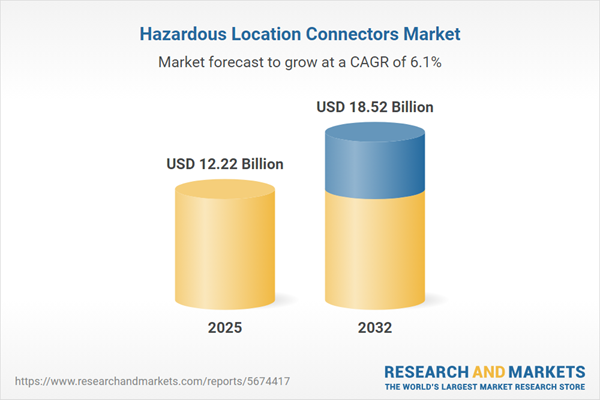Speak directly to the analyst to clarify any post sales queries you may have.
The hazardous location connectors market is evolving rapidly, propelled by heightened regulatory standards and the growing integration of digital technologies across industrial sectors. Senior decision-makers face increased complexity when optimizing connector choices for critical, high-risk environments.
Market Snapshot: Hazardous Location Connectors Market Overview
The global hazardous location connectors market expanded from USD 11.53 billion in 2024 to USD 12.22 billion in 2025. It is projected to continue on this growth trajectory at a CAGR of 6.10%, reaching an expected USD 18.52 billion by 2032. This growth reflects the dual demand for robust safety compliance and resilient connectivity amid ongoing industrial automation, presenting new challenges and opportunities for procurement and engineering leaders.
Scope & Segmentation: Critical Areas of Analysis
- End Use: Chemical and petrochemical processing, food and beverage manufacturing, mining, oil and gas operations, pharmaceutical production, and energy generation comprise the core industries evaluated in the report.
- Connector Type: Circular (including bayonet, push-pull, threaded), multi-pin (coaxial, high-density pin, standard pin), rectangular (flanged, panel mount, surface mount) configurations shape product development and adaptation.
- Contact Material: Brass, bronze, copper alloy, and stainless steel options address conductive performance, reliability, and environmental compatibility.
- Cable Type: Polyurethane, PTFE, PVC, and rubber serve varying flexibility, chemical resistance, and durability requirements in demanding environments.
- Features: EMI shielding, explosion proof capabilities, flame retardance, UV resistance, and waterproofing help manufacturers differentiate solutions and respond to stringent client specifications.
- Geographic Coverage: Americas (United States, Canada, Mexico, Brazil, Argentina, Chile, Colombia, Peru), Europe, Middle East, and Africa (including United Kingdom, Germany, France, Russia, Italy, Spain, Netherlands, Sweden, Poland, Switzerland, United Arab Emirates, Saudi Arabia, Qatar, Turkey, Israel, South Africa, Nigeria, Egypt, Kenya), Asia-Pacific (China, India, Japan, Australia, South Korea, Indonesia, Thailand, Malaysia, Singapore, Taiwan).
- Companies Analyzed: TE Connectivity Ltd., Amphenol Corporation, Phoenix Contact GmbH & Co. KG, HARTING Technology Group, Lapp Holding AG, Weidmüller Interface GmbH & Co. KG, Eaton Corporation plc, ABB Ltd., Schneider Electric SE, R. Stahl Schaltgeräte GmbH.
Key Takeaways for Senior Decision-Makers
- Connector selection is mission-critical for safeguarding operational continuity in hazardous settings, with increasing emphasis on both data and power handling capabilities.
- Technological advances in materials, such as hermetic sealing and corrosion-resistant alloys, are meeting heightened performance standards in environments with explosive gases, dust, or chemicals.
- Digitalization trends are driving demand for connectors with integrated monitoring, enhanced electromagnetic compatibility, and cybersecurity-ready features, especially for facilities deploying smart sensors and edge devices.
- Industry-specific needs create strong differentiation: pharmaceutical and food sectors seek ultra-clean, validated components, while extractive industries demand ruggedness and field versatility.
- Modular product platforms and digital simulation approaches are enabling rapid customization, streamlining inventories, and expediting field deployment of connectors.
- Strategic alliances and lifecycle support services, such as predictive maintenance and on-site training, increasingly influence procurement choices and long-term vendor relationships.
Tariff Impact and Global Supply Chain Adjustments
The introduction of new United States tariffs in 2025 has altered supply chain dynamics for hazardous location connectors. These measures target specialty raw materials, necessitating supplier diversification and prompting manufacturers to consider domestic capabilities and long-term sourcing agreements. Distributors, contract manufacturers, and end users are revisiting pricing models, safety stock levels, and production footprints to navigate cost volatility and ensure material availability. Collaborative relationships with offshore and domestic partners are strengthening supply chain transparency and proactive risk management.
Methodology & Data Sources
This report applies a robust research design, blending structured interviews with procurement, engineering, and safety professionals, on-site observations at production and testing facilities, and comprehensive reviews of industry documentation and company financials. Quantitative models and expert panel reviews validate findings and ensure the integrity of insights for executive decision-making.
Hazardous Location Connectors Market: Why This Report Matters
- This report empowers leaders to anticipate regulatory shifts and digital transformation trends that directly affect project planning and operational safety.
- Strategic segmentation analysis supports targeted investment and procurement strategies, tailored to both industry demands and regional standards.
- Guidance on best practices for lifecycle management, supply chain resilience, and compliance streamlines the decision process for high-stake environments.
Conclusion
The hazardous location connectors market requires adaptive strategies and continuous innovation to address evolving safety, performance, and regulatory demands. Stakeholders armed with in-depth insights can enhance risk mitigation and sustain a competitive edge in dynamic industrial landscapes.
Additional Product Information:
- Purchase of this report includes 1 year online access with quarterly updates.
- This report can be updated on request. Please contact our Customer Experience team using the Ask a Question widget on our website.
Table of Contents
3. Executive Summary
4. Market Overview
7. Cumulative Impact of Artificial Intelligence 2025
Companies Mentioned
The companies profiled in this Hazardous Location Connectors market report include:- TE Connectivity Ltd.
- Amphenol Corporation
- Phoenix Contact GmbH & Co. KG
- HARTING Technology Group
- Lapp Holding AG
- Weidmüller Interface GmbH & Co. KG
- Eaton Corporation plc
- ABB Ltd.
- Schneider Electric SE
- R. Stahl Schaltgeräte GmbH
Table Information
| Report Attribute | Details |
|---|---|
| No. of Pages | 182 |
| Published | October 2025 |
| Forecast Period | 2025 - 2032 |
| Estimated Market Value ( USD | $ 12.22 Billion |
| Forecasted Market Value ( USD | $ 18.52 Billion |
| Compound Annual Growth Rate | 6.1% |
| Regions Covered | Global |
| No. of Companies Mentioned | 11 |









